
| ||||
|---|---|---|---|---|
 |
 |
 |
 |
 |

| ||||
|---|---|---|---|---|
 |
 |
 |
 |
 |
The Goodyear Blimp — N10A “The Spirit of America”
4 August 2006
On 4 August 2006, the Goodyear Tire & Rubber Company invited Carol and John of Skytamer Images for a ride in N10A “The Spirit of America.” A ride in the Goodyear Blimp is one of those “once in a lifetime” experiences that you will always cherish. We are very pleased to share our experience with you as we present a photo travel log of our adventure. However, before we start off with the photos, let's examine the basic layout of the Goodyear Blimp and talk about Goodyear's “Airship” tradition.
Anatomy of a Blimp
The anatomy of the Goodyear blimp, its specifications, and its special features are shown in the drawing below.
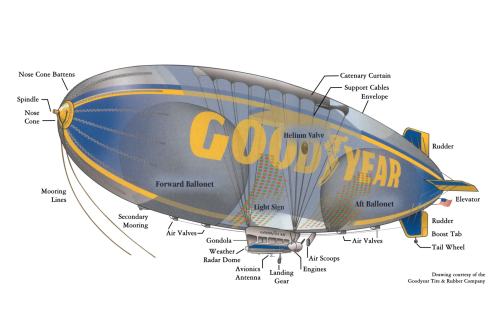
| Specifications & Features | |
|---|---|
| Length: | 192 feet |
| Width: | 50 feet |
| Height: | 59.5 feet |
| Volume: | 202,700 cubic feet |
| Maximum Weight: | 12,840 lbs. |
| Maximum Speed: | 50 mph |
| Cruise Speed: | 30 mph |
| Passenger Seats: | 6, plus pilot |
Modern Flight Controls
When we boarded “The Spirit of America,” I was impressed with the modern flight controls. The Pilot sits in the first row on the port side of the cabin. The modern flight controls at the pilot's fingertips are shown below. In addition to the normal instrumentation that you would expect on any aircraft, there are numerous valves that must be activated to adjust the pitch of the airship. In addition to the pilot, the cabin accommodates six lucky passengers. John lucked out and was seated next to the pilot in the front row on the starboard side. There are three rows of seats in the cabin. The Back row seats three passengers, the middle row seats two passengers, and the front row seats one passenger and the pilot. There are no seat belts.
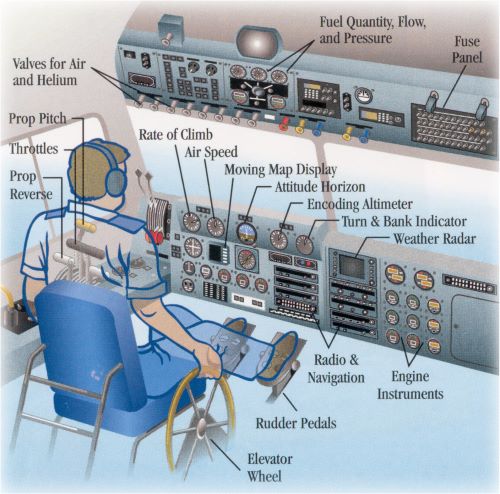
Goodyear Blimp Flight Controls (Goodyear drawing)
Blimp Nomenclature
Envelope: The largest component of a blimp, made of two-ply neoprene-impregnated polyester fabric. It holds the helium that makes the blimp lighter than air.
Helium Valve: Allows the pilot to release helium, if necessary.
Forward and Aft Ballonets: Air bags inside the envelope that help maintain a constant pressure in the envelope.
Catenary Curtain: Cemented to the inside of the envelope, it supports the gondola through cables.
Gondola: Passenger cabin.
Rudders and Elevators: The fins that control the direction of flight.
Engines: Provide blimp's thrust.
Landing Gear: One wheel helps steady the blimp during landing.
Nose Cone Battens: Supports the nose of the blimp. Also used to help moor of the lamp.
Hand Rail: Allows ground crew to hold blimp during takeoff and landing. Crew also uses it to "weigh" blimp before takeoff to determine the amount of ballast needed to compensate for fuel that will be turned during the trip, crew grabs railing on both sides of the gondola and lets it go in unison - if blimp rises, it is light; if it drops, it's heavy.
Ballast bags: Heavy-canvas bags filled with 25 pounds of steel pellets and sewn closed. Ballast is used to adjust the weight of the blimp, to varying conditions. Ballast is adjusted before and after flight, never in-flight.
Secondary Mooring: Small attachment can be used to secure blimp to the top of the ground crew's bus.
Truck: The 18-wheeler's trailer not only contains a powerful generator to provide electricity in remote locations, it also houses maintenance shops where electronic technicians, mechanics and riggers maintain the blimp's systems in top condition while traveling across the country. Its stores spare parts and all the necessary equipment for remote setup and operation.
Bus: Primarily used for ground crew transportation and two-way communication with the blimp during travel operations. The bus contains a complete administrative office were the daily routine of paperwork and record-keeping is conducted.
Van: A utility vehicle, fully equipped with two-way communications. It is an integral part of the caravan, used for crew transportation to and from overnight accommodations, while on travel assignments and as a shuttle to take passengers from the airport building to the blimp for the ride of a lifetime.
Goodyear's Airship History & Tradition
Since 1925, Goodyear blimps have adorned the skies as very visible corporate icons of the world's largest tire and rubber company that began operations in 1898.
Today, Goodyear's graceful giants, known as “Aerial Ambassadors”, travel around the United States drawing children and adults to nearby airports to catch a closer glimpse. Standing awed and excited, parents are usually seen lifting their small children up onto their shoulders to get a better look at one of the most romantic visions of flight.
Goodyear's blimp tradition began when the company built its first helium-filled public relationship airship, the Pilgrim. The tire company painted its name on the side and began barnstorming the United States - humble beginnings to an illustrious history.
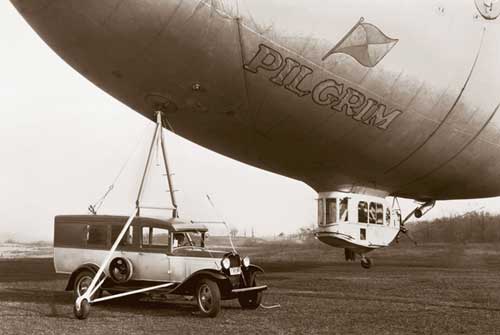
Goodyear Blimp &“Pilgrim” c.1925 (Goodyear photo)
Over the years, Goodyear built more than 300 airships, more than any other company in the world. Akron, Ohio, the company's world headquarters, was a center of blimp manufacturing for several decades.
During World War II, many of the Goodyear-built airships provided the United States Navy, with a unique aerial surveillance capability. Often used as convoy escorts, the blimps were able to look down on the ocean surface, spot enemy submarines and radio their position to the convoy surface ships … in essence, acting as an early warning system. Modern surveillance technology eventually eclipsed the advantages of the airship fleet, and in 1962 the Navy discontinued the program.
Goodyear Blimp Fleet
Today, The Goodyear Tire & Rubber Company operates three well-recognize blimps in the United States: the “Spirit of Goodyear”, based in Akron, Ohio; the “Spirit of America”, based in Carson, California; and the “Stars, & Stripes”, in Pompano Beach, Florida.
All three Goodyear blimps fly year-round and travel throughout United States, together logging nearly 6,000 hours of flight time annually on the road and at their home bases. The “Spirit of Goodyear” and “The Stars & Stripes” share territory carrying the company's message to nearly every state east of the Rockies, as well as Canada and Mexico. The “Spirit of America”, flies the West Coast, Nevada, Arizona and western Canada. In a rare appearance together, not seen in several decades, for Goodyear blimps gathered near Akron, Ohio in 2002. The occasion: the California-based blimp “Eagle” was brought to Ohio to be retired and replaced by the new “Spirit of America”.
Goodyear in Lights and Sound
Goodyear's newest electric sign technology dubbed “EagleVision”, is carried on all three of the U. S. - based Goodyear blimps. This enhanced sign is the latest in a long line of innovative technologies, which have enabled Goodyear to display public service and Goodyear promotional messages on the side of its blimps for more than 70 years.
It began in 1930. The Charleston was the dance rage, E. Scott Fitzgerald's novel “The Great Gatsby” was hitting the bookstores and the Goodyear blimp “Defender” became the first airship in the world to carry a lighted sign.

Goodyear Blimp “Defender” c.1929 (Goodyear photo)
Named “Neon-O-Gram”, ten removable aluminum frame panels were attached to the side of the “Defender” allowing a static text to be displayed using neon light tubes. Each frame weighed 35 pounds and stood 6 feet tall and 4 feet wide.
In 1947, Goodyear replaced the neon tubes with 182 individual incandescent bulbs, which lit up the sky with the Goodyear logo and a winged foot trademark. This type of static display remains standard on the Goodyear blimps until 1966, when a semi-animated nights sign, named “Skytacular”, was developed.
First installed and used in the airship, “Mayflower”, “Skytacular” was a colorful leap forward from 182 white light bulbs to 1,540 lights per side in red, green, yellow and blue, and was the first Goodyear blimp sign to add moving figures and text. To accomplish this, a punched tape was encoded with holes; it was then passed over a pool of mercury in a device called a Mercury reader. An electronic contact was completed, each time a whole passed over the Mercury, which then turned on these specific light. “Skytacular” was eventually converted to computers, with data transferred to lights through the use of magnetic tape and then floppy disks.
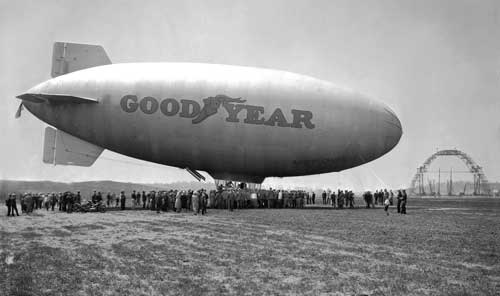
Goodyear Blimp “Mayflower” c.1929 (Goodyear photo)
In 1969, “Skytacular” was upgraded by doubling the number of lights to 3,780 and renamed “Super Skytacular”. Able to flash public service announcements and colorful text and animation visible up to one mile, “Super Skytacular” became very popular with the public and valuable for promoting Goodyear products and service.
In 1996, some of Goodyear's blimps were upgraded with a sign technology named “Super Skytacular 2”. Each side of “Super Skytacular 2” displayed 3,780 light-emitting diode (LED) boards to connected by 1.75 miles of wire. Each board was approximately 2 x 3 inches in size and comprised of 12 LED's, separated into four groups, each group consisting of three LED's - red, green and blue.
The intensity of each LED could be adjusted or “blended” to create a palette of 32,768 possible colors, from which 256 colors could be simultaneously displayed. Such high resolution allowed the creation of some “Skytacular” animation and graphics. As part of the 3,780 light boards, 1,036 were equipped with an additional 36 high-intensity red-orange LED's producing enough light to make messages easily visible during the day.
Today's Goodyear blimps carry the next step in the evolution of the technology - “EagleVision”. It maintains the same number of LED's, but with improved LED hardware, state-of-the-art computers and software, and a generous dose of Goodyear innovation. The result is a high-resolution signed capable of super billion text, smooth animation and, for the first time, real video!

Goodyear's “EagleVision LED's” (Goodyear drawing)
Whether the message contains text, graphics or video, it's all considered animation, which is constructed frame by frame using animation software. The finished file (message) is displayed on the light boards using specially designed hardware and player program.
At times, more than 50% of the messages flashed on electronic signs of the Goodyear airships are devoted to public service. The remainder is used for Goodyear marketing and dealer support promotions.
A spinning Goodyear logo, a United Way emblem, a speeding car, and dazzling fireworks are all part of the Goodyear signed animation library, which expands its catalog each year.
Over the years, Goodyear has utilized its plans in a number of unique ways to reach the public. Beginning in 1940, it wasn't unusual for a blimp to tow a banner or talk! Equipped with a record player, microphone and attached loudspeaker, the Goodyear blimp's “Reliance” and “Ranger&rdquo would blimpcast recordings and live greetings to the public below, while banner-only airships would occasionally advertise commercial offerings such as soft drinks. These ventures into unconventional advertising were eventually discarded, leaving the lighted sign as the preferred format.
To this day when every Goodyear blimp is flying, its side is most likely brightly lighted and providing a spectacular light show. So look up to the sky!
Goodyear's Skilled Personnel & Special Equipment
Each of Goodyear airship has a team of highly qualified Specialist, safety operating equipment, much of which is specially designed for the airship program. For pilots, 16 ground crew members and public relations manager support and manage each operation. As special ambassadors of the company, each associate comes in contact with thousands of people each year. Personnel are selected for their communication skills as well as professional abilities.
The pilot-in-charge of each operation is responsible for the crew and equipment. Based on weather conditions and other circumstances, the decision to fly on any given day belongs to the pilot-in-charge.
New pilots must undergo a comprehensive Goodyear lighter-than-year (LTA) flight training program that can last six months. On successful Federal Aviation Administration testing, the pilot receives an LTA airship rating.
Crew members serve dual roles. In addition to landing and launching the airship during flight operations, a service electronic technicians, airship and vehicle mechanics, rigors and administrative assistants.
Each operation travels with a small fleet of ground support vehicles including a large bus, a tractor-trailer rig and a passenger van.

Goodyear's Ground Fleet (Goodyear drawing)
The bus serves as a role in administrative office and ground crews transportation. The tractor-trailer rig houses, shops were electronic technicians and mechanic and perform repairs in the field when necessary. The van is used as a command car, passenger shuttle and utility vehicle.
The airship and all the vehicles are linked by private two-way radio communications.
The Goodyear Blimp and Television
There's nothing like a view from above in the Goodyear blimps were the first to provide such regular sports coverage, beginning with Orange bowl in 1960. During those early days of television network, provided the cameras, which Goodyear adapted to the blimp, and their operators. The blimps inherent stability made it ideal for providing spectacular views on the world below, and soon became the standard for group coverage … a standard that continues to this day.

Goodyear's Camera System (Goodyear drawing)
Always striving to stay on the cutting edge, Goodyear, in cooperation with others, developed a superior technology to enhance stability and image resolution and began training and using its own camera operators. Using Gyrocam 360, a state-of-the-art gyro-stabilized television mount suspended below the Goodyear blimp's gondola, sports fans are routinely treated to panoramic replays of the running Back's dash to the goal line, baseballs flying out of stadiums or their favorite race car crossing the finish line. The professional results make it look easy! However, behind the scenes it's all serious work.
Often, on-air for more than four hours at a time, and in the air for up to 10 hours, the blimp pilot and Goodyear's camera operator must listen carefully for the director's orders. And both must work together to put the blimp in the optimal position for providing the best possible picture. It has been said that the Goodyear blimp is the best seat “above” the house.
N10A Trip Photo Essay
Our adventure on the “Spirit of America” was scheduled for 3:00 p.m., so we arrived early and were able to photograph some takeoffs and landings of the earlier flights. We then checked into the office and received our preflight briefing. The six passengers and pilot assembled outside the office and we then proceeded with our pilot out to the holding area on the landing field. As the steady engine drone of the “Spirit of America” kept getting louder, we watched the giant blimp descend towards us.





As the two mooring lines came into contact with the ground, we watched the ground crew split into four subgroups and spring into action. Two of the groups grabbed the two mooring lines on the nose of the blimp, while the other two groups grabbed the left and right handrails located on the sides of the gondola. As the ground crew chief gave instructions to the ground crew, they held the airship steady, using the nose lines and the handrails. A boarding ladder was then hung on the starboard side of the gondola, just below the cabin door. At this point, two passengers from the arriving flight climbed down the ladder and two new passengers climbed up the ladder into the cabin. This process was repeated several times until the six new passengers and the new pilot were all safely aboard. After the ground crew had made some ballast adjustments, the Spirit of America was ready to be launched.








The takeoff procedure sort of reminded me of bouncing a giant beach ball into the air. The ground crew grabbed the hand rails on each side of the gondola and pushed the blimp down onto its main landing gear. As the blimp rebounded off its landing gear, it bounced a little higher into the air. The process was repeated a couple of times and then the pilot throttled up the engines and we climbed out and up into the Southern California sky.
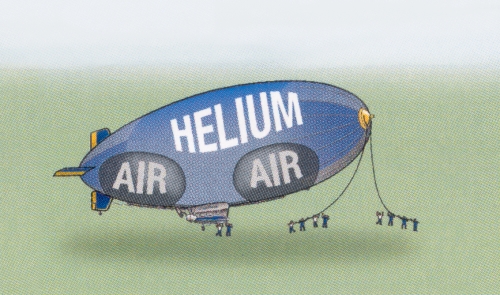
Takeoff - both aft and forward ballonets fully inflated with air. (Goodyear drawing)
The pilot uses the elevator wheel, rudder controls and engine power to gain altitude. The blimp climbs to its normal cruise altitude of about 1,500 feet above ground level. As the blimp rises into the air the decrease in atmospheric pressure allows the helium to expand, requiring the pilot to release air from the ballonets through the air valves.









As we climbed into the air above Carson, California, we slowly turned and headed towards our first waypoint … the Queen Mary, located in the Long Beach Harbor. As we streaked across the heavens at 30 mph at an altitude of 1,500 feet we experienced a very smooth and comfortable ride. In order to talk to the pilot and our fellow passengers, we all wore headsets. The engine drone is so noisy that it is impossible to carry on a conversation without the headsets. The scenery was spectacular. A tad bid slower than a SR-71A, the Goodyear blimp has to be second best photo platform ever deployed.
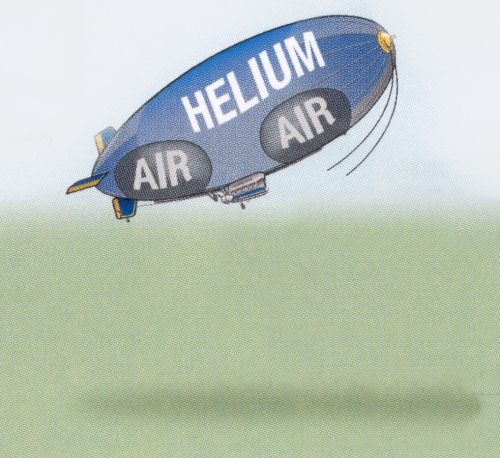
Ascent - Pilot goes to full-power on the engines. As the blimp gains altitude, the helium expands and the air ballonets contract. (Goodyear drawing)
There is no internal structure in a Goodyear blimp. Changes in temperature and atmospheric pressure affect the helium, which, along with air, maintains the blimp's shape.
After reaching the Long Beach Harbor / Queen Mary area, we headed off towards the Palos Verdes Peninsula. On the way we passed over the “Sea Launch” fleet moored in Long Beach Harbor. We then passed over the San Pedro area were we turned again and started to head Back towards the Carson area.

Cruise - Helium has expanded to its maximum volume and the two air ballonets have contracted to their minimum volume. (Goodyear drawing)































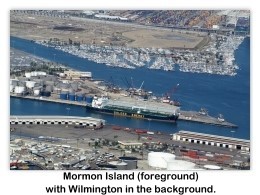
As we approached the Carson area we passed over the Home Depot X-Games Stadium. The dreaded I-405 and then the Goodyear Airship Operations complex came into view.
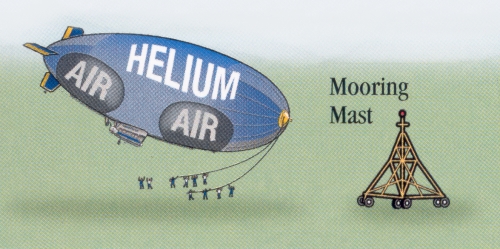
Landing - As we reduced our altitude, the volume of helium decreased and the two ballonets increased in volume. (Goodyear drawing)
At this point, the pilot started the landing procedures. In order to land, the pilot uses engine power, rudder controls and the elevator to fly the blimp toward the waiting ground crew. As the blimp descends the outside atmospheric pressure increases making the helium contract. This contraction causes the ballonets to automatically inflate with air to maintain a constant pressure inside the envelope.



























As the circular dot in the middle of the landing field got larger and larger, we could see the Goodyear ground crew preparing to welcome the Spirit of America home. The ground crew once again sprung into action to secure the airship. Upon exiting the Spirit of America, we all realized that we had just taken a trip that we'll never forget! Thank you Goodyear … and thank you Henry, for making our trip possible.
For more information about the Goodyear blimps be sure to visit their official website clicking on the below photo.
Copyright © 1998-Present, Skytamer Images, Whittier, California
All rights reserved